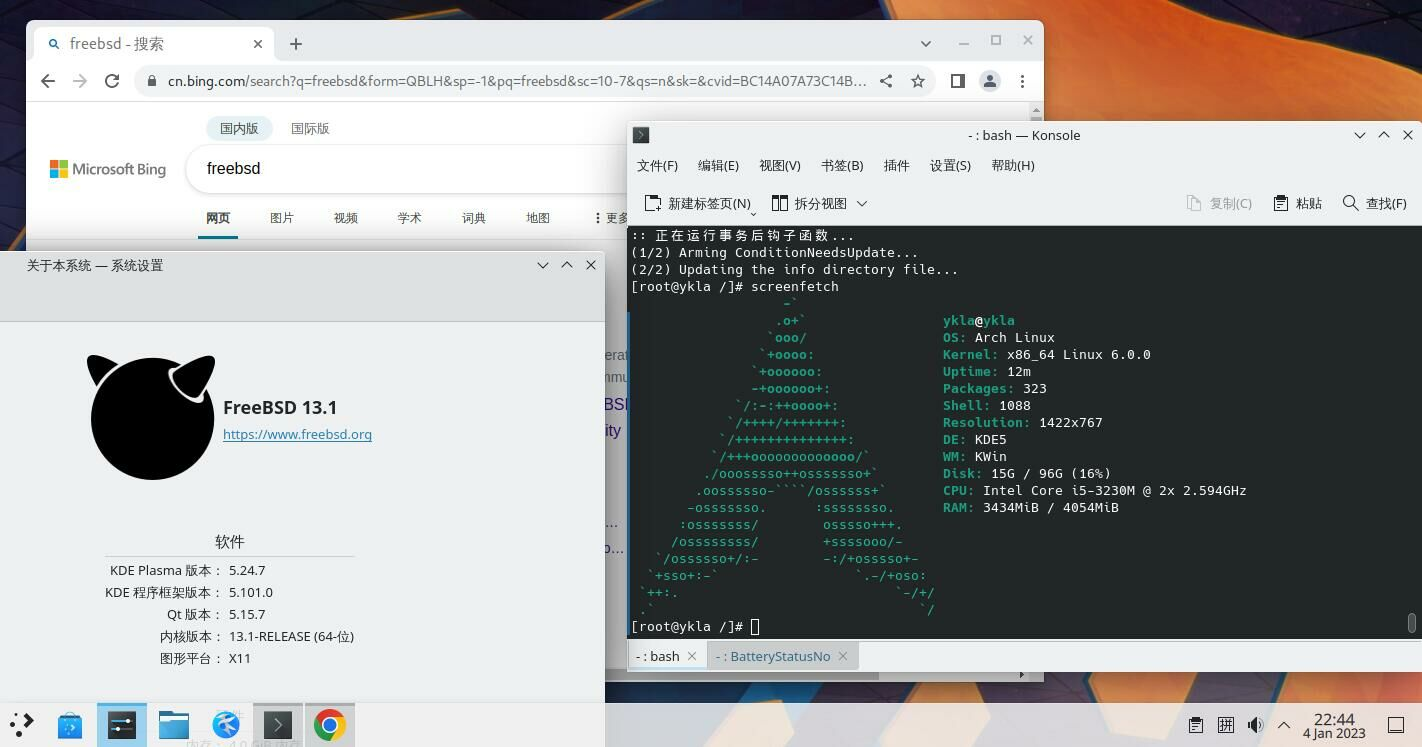第 30.4 Linux 兼容层——基于 ArchLinux bootstrap
ArchLinux 兼容层

注:ArchLinux 兼容层看上去占用略大于 Ubuntu 兼容层是因为后方运行的谷歌 Chrome 浏览器。
以下部分参考 从现有 Linux 发行版安装 Arch Linux。
由于 Linux 兼容层默认内核是 3.17 版本,太低了。直接构建的话,Arch 兼容层会在 chroot 的时候报错 FATAL: kernel too old。需要把 Linux 兼容层的内核版本改为 6.2.10(或其他较高版本)才可以:
# echo "compat.linux.osrelease=6.2.10" >> /etc/sysctl.conf
即可永久生效。
构建基本系统
# sysrc linux_enable="YES"
# sysrc kld_list+="linux linux64"
# kldload linux64
# service linux start
# sysrc dbus_enable="YES" #一般桌面已经配置
# service dbus start #一般桌面已经配置
# cd /home/ykla
# fetch http://mirrors.cqu.edu.cn/archlinux/iso/latest/archlinux-bootstrap-x86_64.tar.gz
# tar xpvf archlinux-bootstrap-x86_64.tar.gz -C /compat --numeric-owner # 若有报错 exit 请无视之。-
# mv /compat/root.x86_64 /compat/arch # 重命名 /
挂载文件系统
将 nullfs_load="YES" 写入 /boot/loader.conf。
将以下行写入/etc/fstab:
# Device Mountpoint FStype Options Dump Pass#
devfs /compat/arch/dev devfs rw,late 0 0
tmpfs /compat/arch/dev/shm tmpfs rw,late,size=1g,mode=1777 0 0
fdescfs /compat/arch/dev/fd fdescfs rw,late,linrdlnk 0 0
linprocfs /compat/arch/proc linprocfs rw,late 0 0
linsysfs /compat/arch/sys linsysfs rw,late 0 0
/tmp /compat/arch/tmp nullfs rw,late 0 0
#/home /compat/arch/home nullfs rw,late 0 0
检查挂载有无报错:
# mount -al
如果提示没有 home 文件夹,请新建之:
# mkdir /compat/arch/home
重启:
# reboot
基本配置
初始化 pacman 密匙环
# cp /etc/resolv.conf /compat/arch/etc/ # 此时位于 FreeBSD!复制 DNS 解析。
# chroot /compat/arch /bin/bash # 此时已经是 Arch 兼容层了!
# pacman-key --init
# pacman-key --populate archlinux
换源
由于新安装的 Arch 没有任何文本管理器,所以我们需要在 FreeBSD 中编辑相关文件:
# ee /compat/arch/etc/pacman.d/mirrorlist # 此时位于 FreeBSD!将下行添加至文件顶部。
Server = https://mirrors.tuna.tsinghua.edu.cn/archlinux/$repo/os/$arch
安装一些基本软件:
# pacman -S base base-devel nano yay wqy-zenhei
archlinuxcn 源配置
# nano /etc/pacman.conf # 将下两行添加至文件底部。
[archlinuxcn]
Server = https://mirrors.tuna.tsinghua.edu.cn/archlinuxcn/$arch
导入密钥:
# pacman -S archlinuxcn-keyring
提示:在 ==> Locally signing trusted keys in keyring... 这一步可能需要十分钟或更长时间。请耐心等待。
由于 yay 及类似安装 aur 的软件均禁止直接 root,故需要在 chroot 中创建一个普通权限的用户(经测试 FreeBSD 中原有的普通用户不可用):
# useradd -G wheel -m test
编辑 sudo 配置文件(若有红色警告请无视之):
# nano /etc/sudoers
将 # %wheel ALL=(ALL) ALL 前面的 # 删掉。
将 # %sudo ALL=(ALL:ALL) ALL 前面的 # 删掉。
卸载 fakeroot 更改为 fakeroot-tcp,否则无法使用 aur:
该 Bug 见 https://archlinuxarm.org/forum/viewtopic.php?t=14466
# pacman -S fakeroot-tcp #会询问是否卸载 fakeroot,请确认并卸载。
注意,如果为 test 设置了密码但是仍然提示密码错误,你需要新开一个终端,输入 reboot 重启 FreeBSD 然后再继续操作。
区域设置
提示:如果不设置则无法在 ArchLinux 的图形化程序中使用中文输入法。
编辑 /etc/locale.gen,把 zh_CN.UTF-8 UTF-8 前面的注释 # 删掉。
重新生成区域文件:
# locale-gen
Shell 脚本
为方便读者,有如下脚本:
# fetch http://book.bsdcn.org/arch.sh
# sh arch.sh
执行后即可完成安装。
脚本内容如下:
#/bin/sh
rootdir=/compat/arch
url="http://mirrors.cqu.edu.cn/archlinux/iso/latest/archlinux-bootstrap-x86_64.tar.gz"
echo "begin to install archlinux ..."
echo "check modules ..."
# check linux module
if [ "$(sysrc -n linux_enable)" = "NO" ]; then
echo "linux module should be loaded. Continue?(Y|n)"
read answer
case $answer in
[Nn][Oo]|[Nn])
echo "linux module not loaded"
exit 1
;;
[Yy][Ee][Ss]|[Yy]|"")
sysrc linux_enable=YES
;;
esac
fi
echo "start linux"
service linux start
# check dbus
if ! /usr/bin/which -s dbus-daemon;then
echo "dbus-daemon not found. install it [Y|n]"
read answer
case $answer in
[Nn][Oo]|[Nn])
echo "dbus not installed"
exit 2
;;
[Yy][Ee][Ss]|[Yy]|"")
pkg install -y dbus
;;
esac
fi
if [ "$(sysrc -n dbus_enable)" != "YES" ]; then
echo "dbus should be enable. Continue?(Y|n)"
read answer
case $answer in
[Nn][Oo]|[Nn])
echo "dbus not running"
exit 2
;;
[Yy][Ee][Ss]|[Yy]|"")
sysrc dbus_enable=YES
;;
esac
fi
echo "start dbus"
service dbus start
echo "now we will bootstrap archlinux"
fetch ${url}
tar xpvf archlinux-bootstrap-x86_64.tar.gz -C /compat --numeric-owner
rm archlinux-bootstrap-x86_64.tar.gz
mv /compat/root.x86_64 ${rootdir}
if [ ! "$(sysrc -f /boot/loader.conf -qn nullfs_load)" = "YES" ]; then
echo "nullfs_load should load. continue? (Y|n)"
read answer
case $answer in
[Nn][Oo]|[Nn])
echo "nullfs not load"
exit 3
;;
[Yy][Ee][Ss]|[Yy]|"")
sysrc -f /boot/loader.conf nullfs_load=yes
;;
esac
fi
if ! kldstat -n nullfs >/dev/null 2>&1;then
echo "load nullfs module"
kldload -v nullfs
fi
echo "mount some fs for linux"
echo "devfs ${rootdir}/dev devfs rw,late 0 0" >> /etc/fstab
echo "tmpfs ${rootdir}/dev/shm tmpfs rw,late,size=1g,mode=1777 0 0" >> /etc/fstab
echo "fdescfs ${rootdir}/dev/fd fdescfs rw,late,linrdlnk 0 0" >> /etc/fstab
echo "linprocfs ${rootdir}/proc linprocfs rw,late 0 0" >> /etc/fstab
echo "linsysfs ${rootdir}/sys linsysfs rw,late 0 0" >> /etc/fstab
echo "/tmp ${rootdir}/tmp nullfs rw,late 0 0" >> /etc/fstab
#echo "/home ${rootdir}/home nullfs rw,late 0 0" >> /etc/fstab
mount -al
echo "for archlinux,we should change 'compat.linux.osrelease'. continue? (Y|n)"
read answer
case $answer in
[Nn][Oo]|[Nn])
echo "close to success"
exit 4
;;
[Yy][Ee][Ss]|[Yy]|"")
echo "compat.linux.osrelease=6.2.10" >> /etc/sysctl.conf
sysctl compat.linux.osrelease=6.2.10
;;
esac
echo "complete!"
echo "to use: chroot ${rootdir} /bin/bash"
echo ""
echo "but for easy use ,i can do some init config"
echo "if agree:"
echo " i set resolv.conf to ali dns"
echo " init pacman keyring"
echo " use tsinghua mirror"
echo "continue?[Y|n]"
read answer
case $answer in
[Nn][Oo]|[Nn])
echo "set your archlinux by yourself.bye!"
exit 0
;;
[Yy][Ee][Ss]|[Yy]|"")
echo "nameserver 223.5.5.5" >> ${rootdir}/etc/resolv.conf
chroot ${rootdir} /bin/bash -c "pacman-key --init"
chroot ${rootdir} /bin/bash -c "pacman-key --populate archlinux"
cat ${rootdir}/etc/pacman.d/mirrorlist > mlst.tmp
echo 'Server = https://mirrors.tuna.tsinghua.edu.cn/archlinux/$repo/os/$arch' > ${rootdir}/etc/pacman.d/mirrorlist
cat mlst.tmp >> ${rootdir}/etc/pacman.d/mirrorlist
rm mlst.tmp
echo '[archlinuxcn]' >> ${rootdir}/etc/pacman.conf
echo 'Server = https://mirrors.tuna.tsinghua.edu.cn/archlinuxcn/$arch' >> ${rootdir}/etc/pacman.conf
echo "Refresh sources and systems"
chroot ${rootdir} /bin/bash -c "pacman -Syyu --noconfirm"
echo "Refresh key"
chroot ${rootdir} /bin/bash -c "pacman -S --noconfirm archlinuxcn-keyring"
echo "Install yay"
chroot ${rootdir} /bin/bash -c "pacman -S --noconfirm yay base base-devel nano yay wqy-zenhei"
echo "Create user"
chroot ${rootdir} /bin/bash -c "useradd -G wheel -m test"
echo "Now modify the sudo configuration"
echo '%wheel ALL=(ALL) ALL' >> ${rootdir}/etc/sudoers
echo '%sudo ALL=(ALL:ALL) ALL' >> ${rootdir}/etc/sudoers
echo "change fakeroot"
chroot ${rootdir} /bin/bash -c "pacman -S --noconfirm fakeroot-tcp"
echo "Make localised settings"
echo 'zh_CN.UTF-8 UTF-8' >> ${rootdir}/etc/locale.gen
chroot ${rootdir} /bin/bash -c "locale-gen"
echo "all done."
;;
esac
echo "Now you can run '#chroot /compat/arch/ /bin/bash' Into ArchLinux"